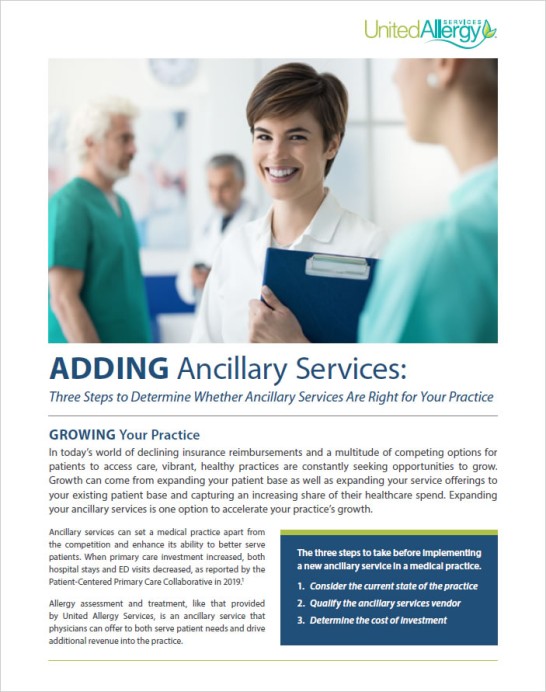In today’s world of declining insurance reimbursements and a multitude of competing options for patients to access care, vibrant, healthy practices are constantly seeking opportunities to grow. Growth can come from expanding your patient base as well as expanding your offerings by offering ancillary medical services to your existing patient base and capturing an increasing share of their healthcare spend.
Growing Your Practice with Ancillary Medical Services
Ancillary medical services can set a practice apart from the competition and enhance its ability to better serve patients. When primary care investment increased, both hospital stays and ED visits decreased, as reported by the Patient-Centered Primary Care Collaborative in 2019.
Allergy assessment and treatment, like that provided by United Allergy Services, is an ancillary service that physicians can offer to both serve patient needs and drive additional revenue into the practice.
Three Steps to Determine Whether Ancillary Medical Services Are Right for Your Practice
Before implementing an additional patient service in a medical practice, take these three steps:
- Consider the current state of the practice
- Qualify the ancillary services vendor
- Determine the cost of investment
1. Reflect on the Practice
The first step is evaluating the practice for untapped potential in both the physical space and services offered. What services are your patients seeking elsewhere either by choice or your referral patterns? These services could be services covered by insurance or they could be consumer-based medical services that your patients are exposed to through other care outlets. The advent of internet-based care outlets has greatly expanded the demand for certain services.
Missed Opportunities
A study published in the Journal of the American Board of Family Medicine (JABFM) noted that physicians are often unable to close the referral loop due to lack of referral completion. In fact, 17% of referred patients do not see the specialist to whom they are referred, according to the JABFM study. Is there a needed service in your community that your practice can fill?
Existing Infrastructure
Available space along with current staff productivity levels and credentials impact the practice’s ability to execute additional patient services. Consider how much time and money it would take for staff education and office renovation before a new service line would be functional in the existing practice.
Patient Evaluation
Alignment with patient needs is critical for the success of any ancillary medical service implementation. Consider the areas of common patient referrals, insurance contracts on file that may influence reimbursement rates, and patient perception of the practice.
17%
of referred patients do not see the specialist to whom they are referred
2. Qualify the Ancillary Medical Services Vendor
Patient care should meet or exceed current practice standards. Ask the vendor:
- What additional patient services do they deliver through implementation and beyond?
- What is their track record?
- What sets them apart from their peers?
Resource Leveraging
A valuable partner will offer provisions that boost the likelihood of success when implementing a new service. Look for available customer support expertise in legal regulations and payer reimbursement for the additional patient services you may onboard. When you meet with a prospective vendor, ask about their expectations regarding qualified candidates for their services and reasonable revenue expectations for the practice.
Vendor Reputation
Partnership with an outside vendor requires a high level of trust. Review the vendor’s references and referrals from colleagues as well as their longevity and experience. Vet potential vendors by researching clinical studies that review the company’s protocols.
3. Determine the Cost of Investment
An expansion of services may require additional resources. Consider the financial investment and the potential ROI opportunity after implementation.
Filling a Gap in the Market
Consider whether adding an ancillary medical service to the practice will be profitable. The most popular ancillary medical services adopted by internal and family medicine are lab services, ECG, prescription dispensing, and radiology/imaging. Adding an ancillary service into a market that is saturated may not be a good business decision. While shopping around for service line vendors, consider what unique market gap you can fill that fits your patient base.
Vendor Buy-In
Choose a vendor with infrastructure to handle not only implementation but staffing and ongoing customer assistance. This backing will help lower upfront costs needed for training and reduce the impact on productivity among existing team members.
What Is Your “Return on Effort“?
Your and your staff’s time is a precious resource. Any investment of time and money should generate a sufficient return to justify the expense. Here are a few questions to answer:
- What is the expected demand for the product or service?
- How will you identify potential patients/consumers?
- What is your investment to initiate the service?
- What is your cost to deliver and maintain the service?
- Is this incremental to your practice, or will this replace or cannibalize some of your existing business?
You do not need an MBA to answer these questions. Your vendor and some common sense can help you answer them. Also, your physician community may have experience with the product or service and can help you develop a simple financial model of the potential revenue and costs.
Does It Work?
Adding a service to a practice should be beneficial for patients and improve ROI for the practice. Adding a service to an existing practice has the potential of improving patient adherence and minimizing the need for referrals overall. 70% of polled physician organization leaders noted that increasing the volume of services delivered is the top action that primary care and specialist physicians could take to increase their compensation.
Take a Look at On-Site Allergy Services
Over 100 million Americans suffer from allergies such as rhinitis (hay fever), food allergies and asthma, but only a fraction seek treatment from an allergist. United Allergy Services (UAS) empowers physicians to offer on-site allergy services that fit seamlessly into existing medical office workflows, expanding delivery of patient services and increasing revenue.
Since 2009, UAS has successfully partnered with more than 2,450 practitioners across 20+ states to deliver proven, flexible and customizable ancillary medical services that directly meet the allergy needs of patients without requiring them to go elsewhere. Treatment protocols include immunotherapy delivered by subcutaneous injections (allergy shots) in the physician’s office or at home as well as sublingual allergy drops self-administered at home by the patient. A UAS treatment group showed >40% improvement in allergy symptom scores compared to control through administration of immunotherapy. A 3-year course of immunotherapy has shown long-term clinical effects and the potential of preventing the development of asthma in children with allergic rhino conjunctivitis up to seven years post-treatment.
UAS medical partners maintain full clinical control and can easily test, treat and educate patients on environmental and food allergies with comprehensive solutions that include staff training, supplies, customer support, patient education tools and marketing materials.
The convenience of in-house allergy care both improves patient quality of life and satisfaction while generating additional revenue for the practice.
Adding Ancillary Services
View, print, or download the PDF version of this blog post: Adding Ancillary Services: Three Steps to Determine Whether Ancillary Services Are Right for Your Practice
You may also be interested in . . .
The Primary Care Practice Crisis: It’s Time to Play Offense
In an article published in Medical Economics, Brad J. Scoggins, FO, DAAP contends that it’s not enough for medical practices to counter adverse market forces by cutting costs and streamlining operations. He argues that practices must take steps to generate more revenue—specifically by offering embedded services from an established specialist provider.
Maximizing Your Practice by Minimizing the Leakage
Does your medical practice have leaks? Is your growth hindered by “lost business” that negates the full impact of new patient growth? One of my favorite business expressions is from Roger Enrico, the former CEO of PepsiCo, who would say: “Growth is what matters.” It was one of the cornerstones that made PepsiCo the evolving company that it is and helped form the company’s distinguishing strategy. Growth Comes in Many Forms Acquiring New Patients Raising Prices Capturing More of Your Existing Patients’…
Why Offer Allergy Care Services in Your Medical Practice?
More than 100 million Americans suffer from environmental, seasonal and perennial allergies, including ragweed, pollen, dust mites and animal dander. In addition, roughly 11% of adults and 7½% of children have a food allergy. Unfortunately, only a fraction seek treatment from a specialist, resulting in an annual cost of $18 billion to the healthcare system and businesses in the U.S.1 Most patients self-medicate with over-the-counter medications, but allergy relief can be elusive. The underlying cause of the…




